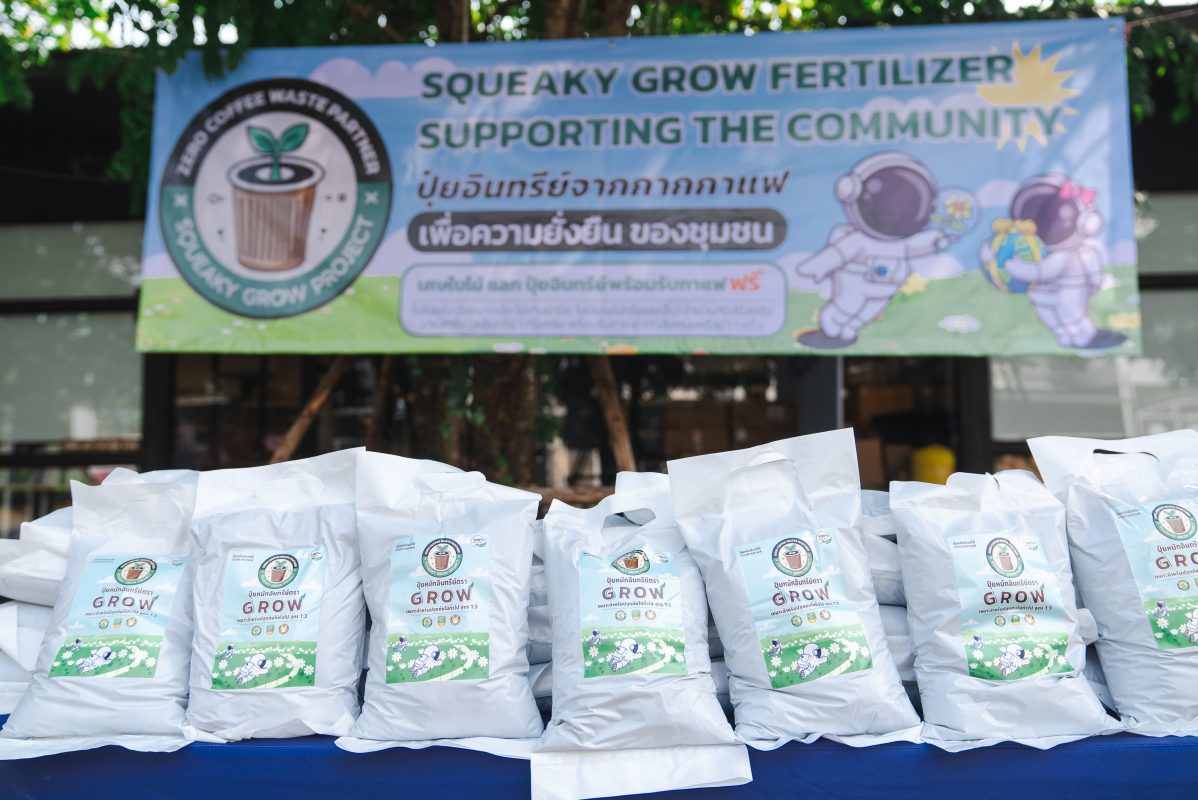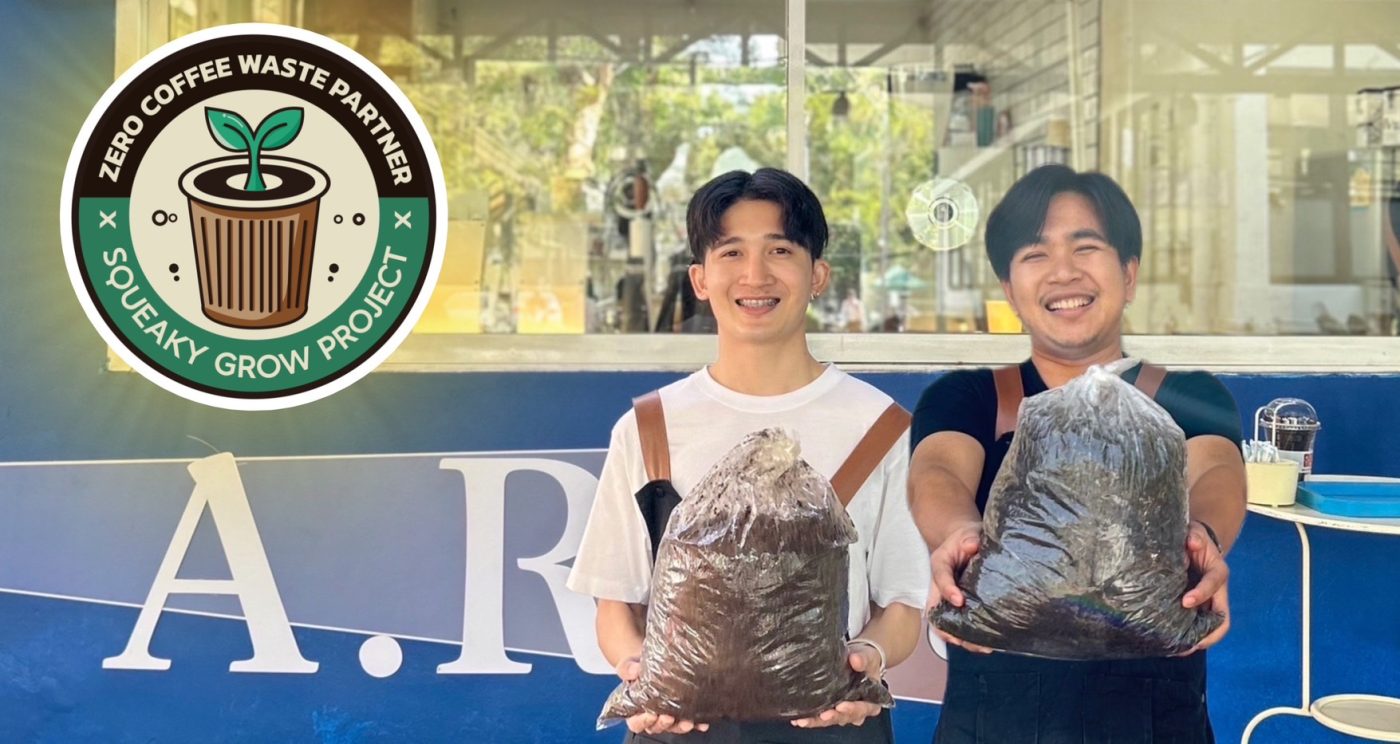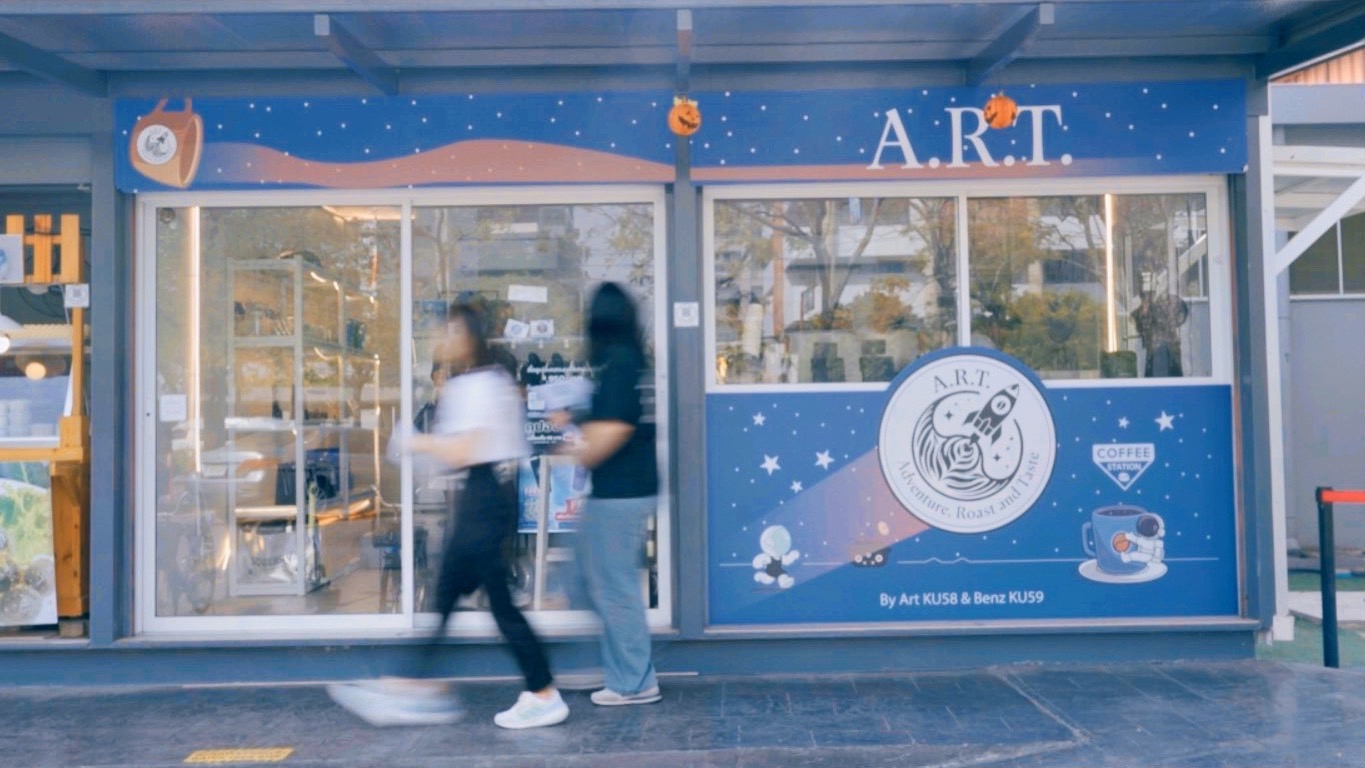
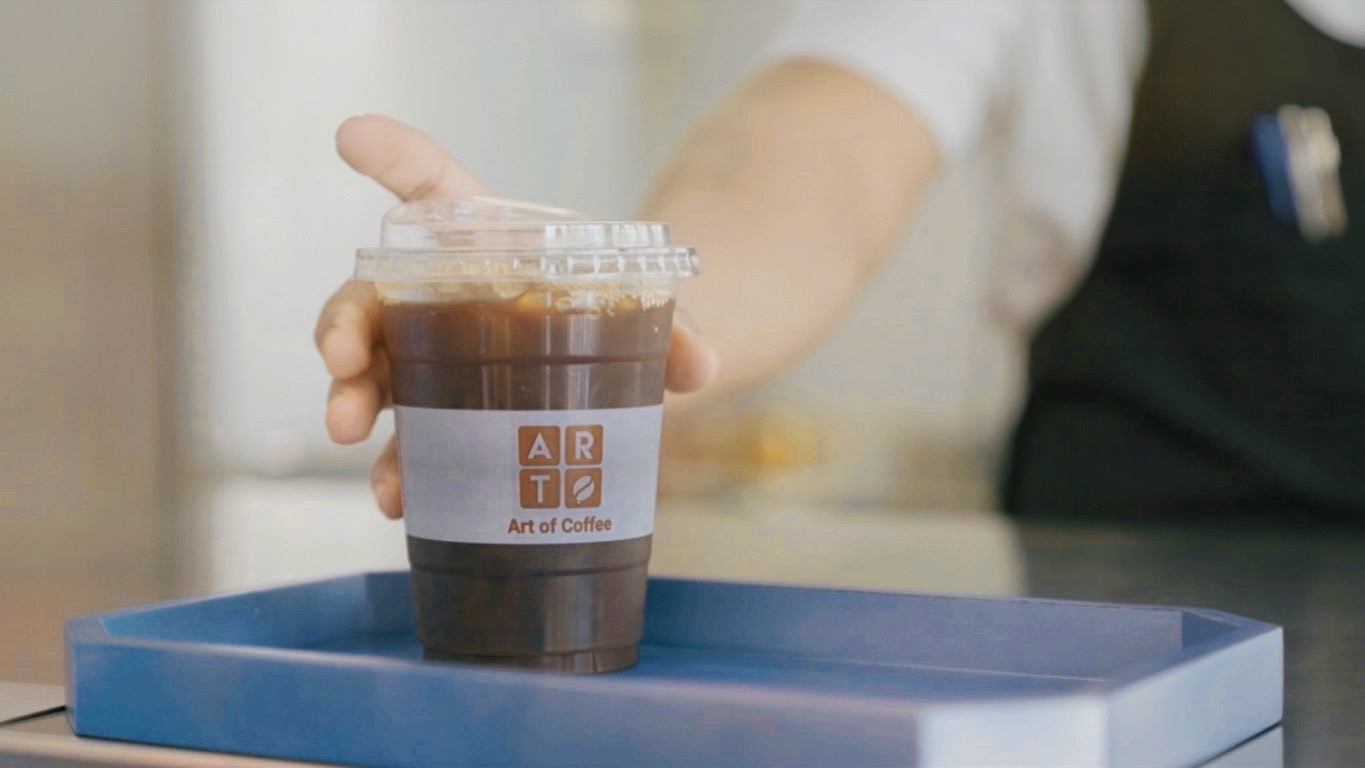
SqueakyGrow: Turning Coffee Waste into a Global Force for Sustainability
In 2020, SqueakyGrow was born from a small coffee shop at Kasetsart University in Thailand: Art of Coffee. With over 17 years of experience, the shop identified an often-overlooked issue with every cup of coffee: coffee waste.
Every time we brew a cup of coffee, we generate 6.6 kilograms of coffee grounds per day from a single small shop. These grounds, which often end up in landfills, produce methane gas, a greenhouse gas that is 25 times more potent than CO2 in causing global warming.
But Art of Coffee didn’t stop at selling coffee. They began experimenting with composting coffee grounds using natural microorganisms like Lactobacillus spp., Bacillus subtilis, and Trichoderma spp. to transform what seemed like worthless waste into high-quality organic fertilizer.
From Small Beginnings to Big Impact
In just 4 years, SqueakyGrow has expanded from a single coffee shop in its first year to a network of 8 shops across Thailand, while also collecting organic materials such as food scraps, banana peels, and pumpkin skins from cafeterias and local businesses.
Tangible Results:
- Reduced coffee waste by 19.28 tons per year
- Reduced methane emissions by 964 kilograms CO2e per year
- Produced 24.1 tons of organic fertilizer annually
The fertilizers are distributed to local farmers at affordable prices, helping to restore soil health, reduce chemical fertilizer use, and improve agricultural productivity.
Consumers: Small Actions, Big Impact
Every cup of coffee you drink can drive change.
- Support sustainable coffee shops:
Choose shops that responsibly manage coffee waste, helping to reduce local landfill contributions. - Raise awareness:
Understand that discarded coffee grounds can be transformed into valuable resources that benefit the planet.
A Story of Collaboration
- Coffee Shops: Reduce waste and set a new standard for sustainable waste management.
- Communities: Minimize local waste and create cleaner environments.
- Farmers: Lower agricultural costs and restore soil with organic fertilizers.
- Consumers: Become part of the solution by supporting a circular economy.
Global Ambitions
SqueakyGrow isn’t stopping at local impacts. Its goal is to scale these efforts globally by sharing its methods through www.squeaky.coffee/grow and inspiring a sustainable coffee ecosystem worldwide.
📌 One cup of coffee can change the world.
Join SqueakyGrow on this journey to create a sustainable future for coffee and beyond 🌱
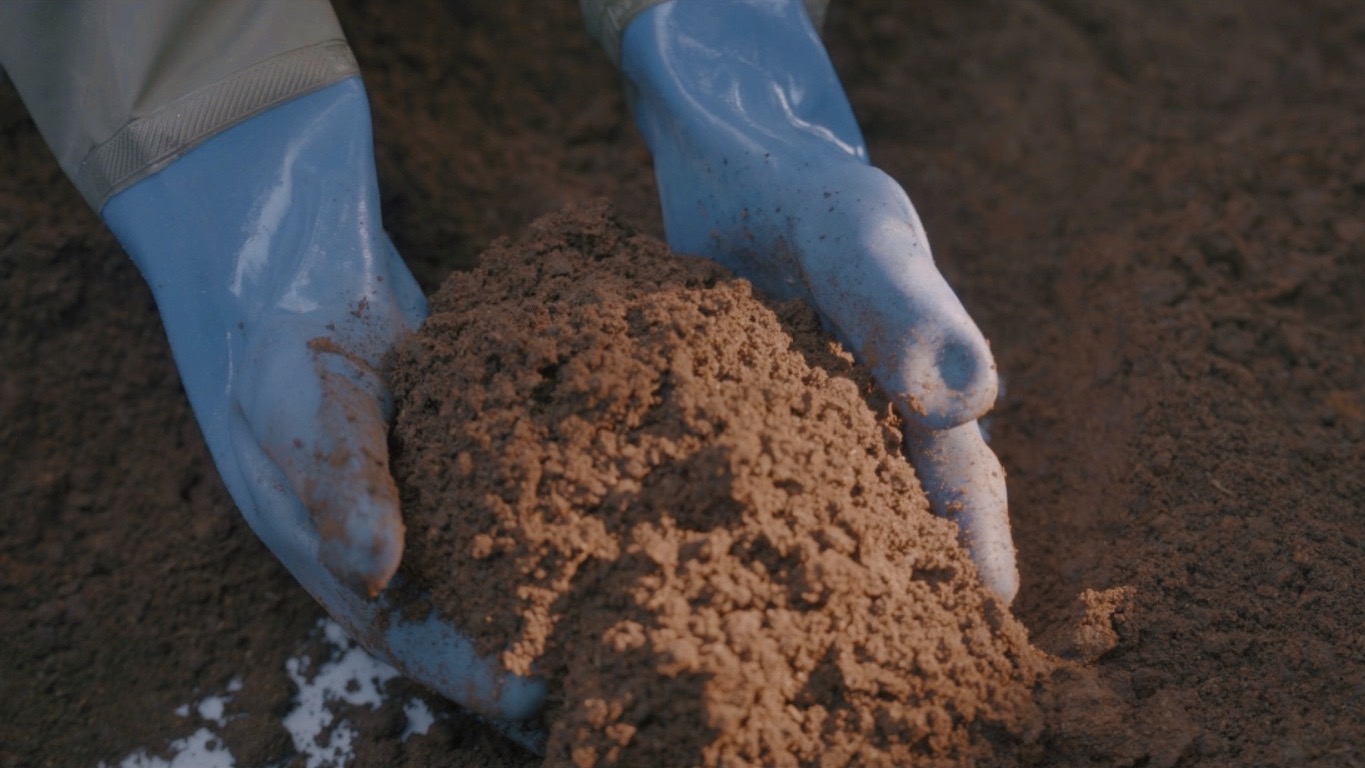
Coffee Grounds
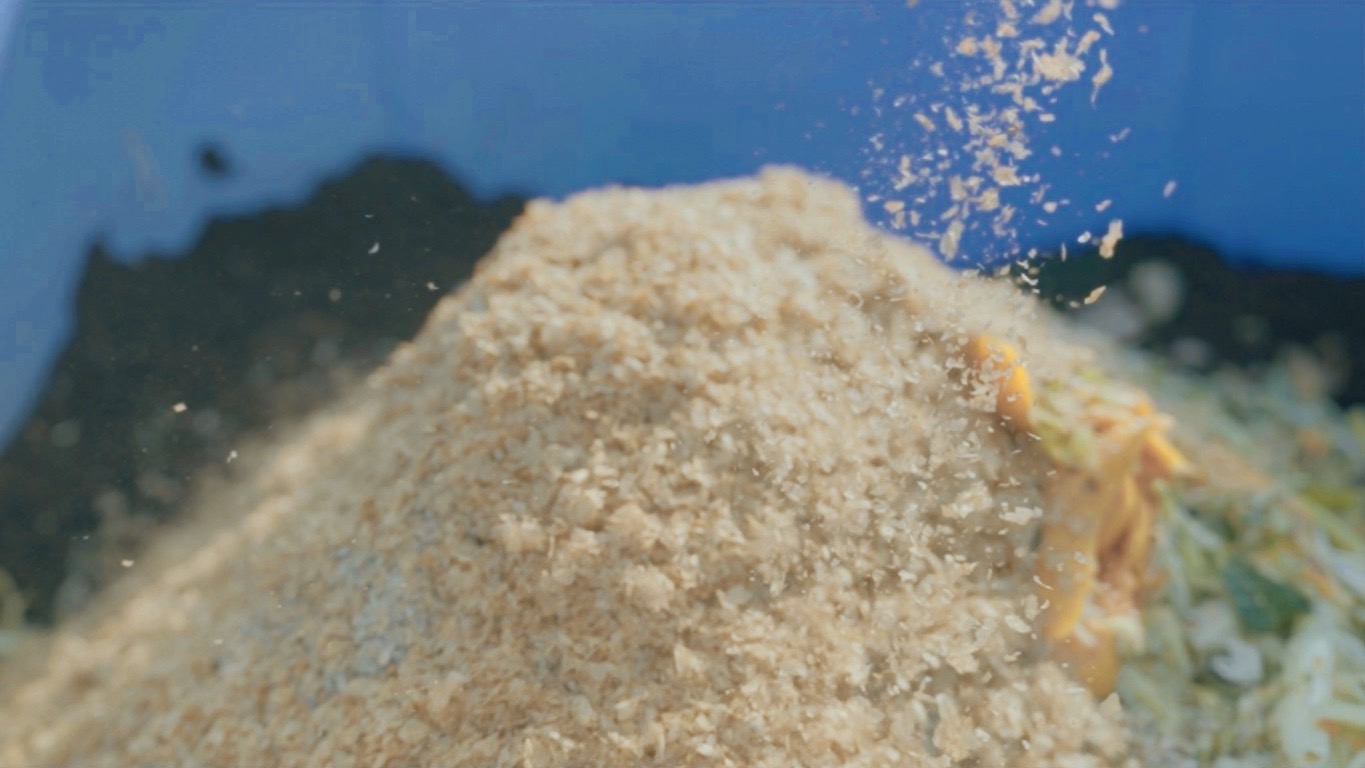
Chaff
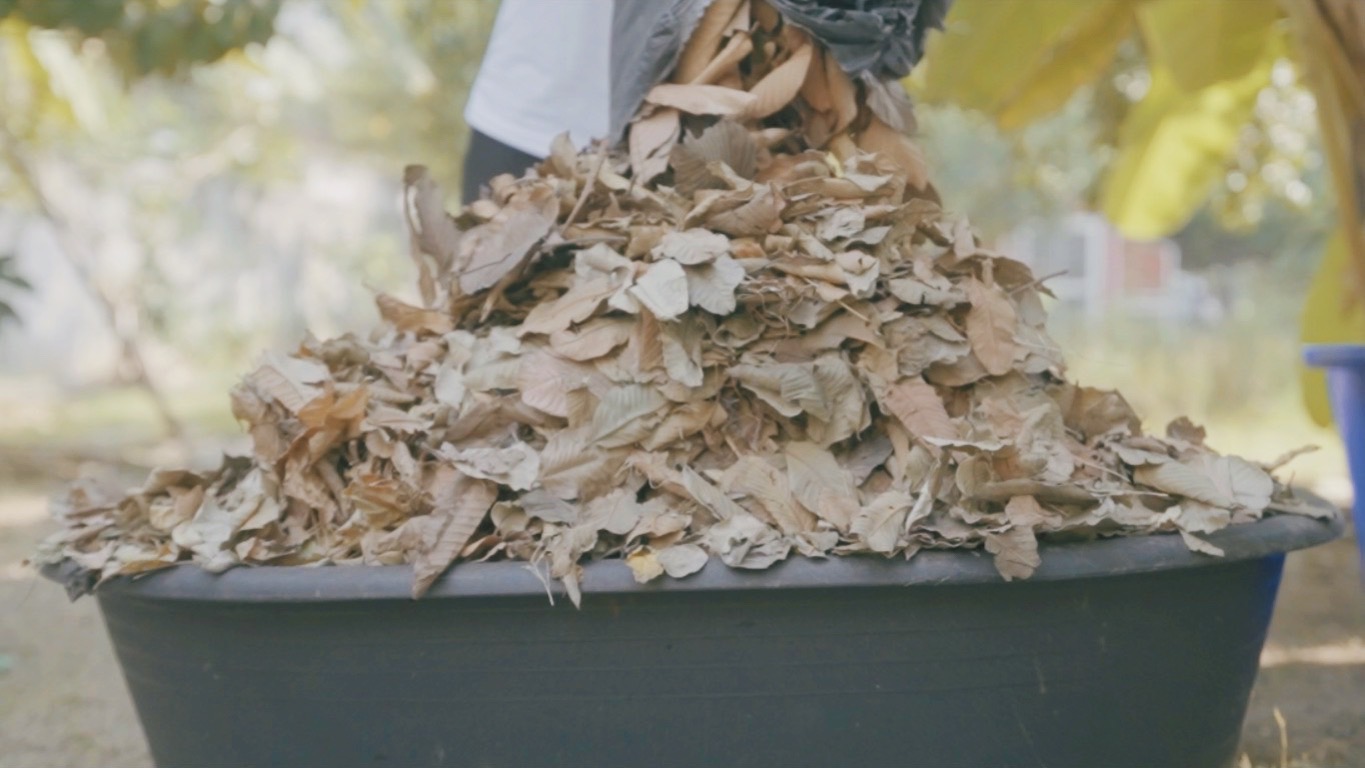
Dry Leaves
How to Make Compost from Coffee Grounds | SqueakyGrow Method
Transforming coffee waste into nutrient-rich compost is a simple and effective way to promote sustainability. Follow these steps to create organic compost using coffee grounds and other biodegradable materials.
1. Materials Needed
Before starting, gather the following ingredients:
• Coffee grounds (40%) – A rich nitrogen source
• Dry leaves or Chaff (30%) – Carbon-rich material for aeration
• Fresh organic waste (20%) – Such as banana peels, fruit peels, or vegetable scraps
• Molasses (2%) – Provides energy for microbial growth
• Water (8%) – Maintains moisture levels for decomposition
• Microorganisms –
- Lactobacillus spp. (found in yogurt): Speeds up decomposition (Add on Day 1)
- Bacillus subtilis: Aids in breaking down organic matter (Add on Day 8)
- Trichoderma spp.: Prevents harmful fungi and improves compost quality (Add on Day 15)
2. Step-by-Step Composting Process
Step 1: Prepare the Compost Bin
• Use a composting bin or a rotating drum (preferably 100-160 liters in size).
• Ensure it has small air holes for aeration but is not completely open.
Step 2: Layer the Ingredients
• Add coffee grounds first, spreading them evenly.
• Mix in dry leaves or other dry organic material.
• Add fresh organic waste like banana peels or fruit scraps.
• Pour in molasses diluted in water to provide a food source for microbes.
Step 3: Add Microorganisms
-
Day 1: Add Lactobacillus spp.
• Mix 200 g of yogurt with 2 liters of water and pour evenly over the compost.
• This helps reduce pH and start the decomposition process. -
Day 8: Add Bacillus subtilis
• Dilute 10 ml of Bacillus subtilis in 5 liters of water.
• Pour over the compost to break down complex organic matter like cellulose and proteins. -
Day 15: Add Trichoderma spp.
• Mix 10 g of Trichoderma spp. with 250 g of rice bran.
• Sprinkle over the compost to prevent harmful fungi and speed up the breakdown of remaining materials.
Step 4: Maintain Moisture & Aeration
• The compost should have 50-60% moisture content (moist but not soggy).
• If it’s too dry, add a little water; if too wet, add more dry materials.
• Stir or rotate the compost bin daily for aeration and even decomposition.
Step 5: Monitor the Compost
• Within 7-10 days, the temperature should rise as decomposition occurs.
• Continue aerating and monitoring for mold growth:
- White fungi: Beneficial and normal.
- Black mold: Harmful; add more dry materials and turn the pile frequently.
• If the compost smells bad, add dry leaves and turn it more often.
Step 6: Compost Completion (30-45 Days)
• By Day 30-45, the compost will be dark, crumbly, and have an earthy smell.
• Once fully decomposed, let it cure for 7 days before use.
3. How to Use the Compost
• For Gardening: Mix 30% compost with soil for better plant growth.
• For Farms: Apply around the base of trees and crops as organic fertilizer.
• For Urban Planting: Use as potting soil for vegetables and herbs.
4. Benefits of Using SqueakyGrow Compost
✅ Reduces waste from coffee shops
✅ Decreases landfill waste and methane emissions
✅ Enriches soil naturally without chemicals
✅ Prevents harmful fungi growth
✅ Supports local farmers & sustainable agriculture
Example : Ingredients for 50 kg Compost
| Ingredient | Percentage | Weight for 50 kg Total |
|---|---|---|
| Coffee Grounds | 40% | 20 kg |
| Dry Leaves | 30% | 15 kg |
| Fresh Organic Waste | 20% | 10 kg |
| Rice Bran | 5% | 2.5 kg |
| Molasses | 2% | 1 liter (~1.4 kg) |
| Water | 15 liters | 15 liters (~15 kg) |
Microorganisms:
- Lactobacillus spp. (yogurt): 100 g (~0.1 kg) – Add on Day 1
- Bacillus subtilis: 10 ml mixed with 5 liters of water – Add on Day 8
- Trichoderma spp.: 5 g mixed with 250 g rice bran – Add on Day 15
Join the SqueakyGrow Movement!
Start composting today and turn your coffee waste into something valuable. 🌱 Sustainable farming
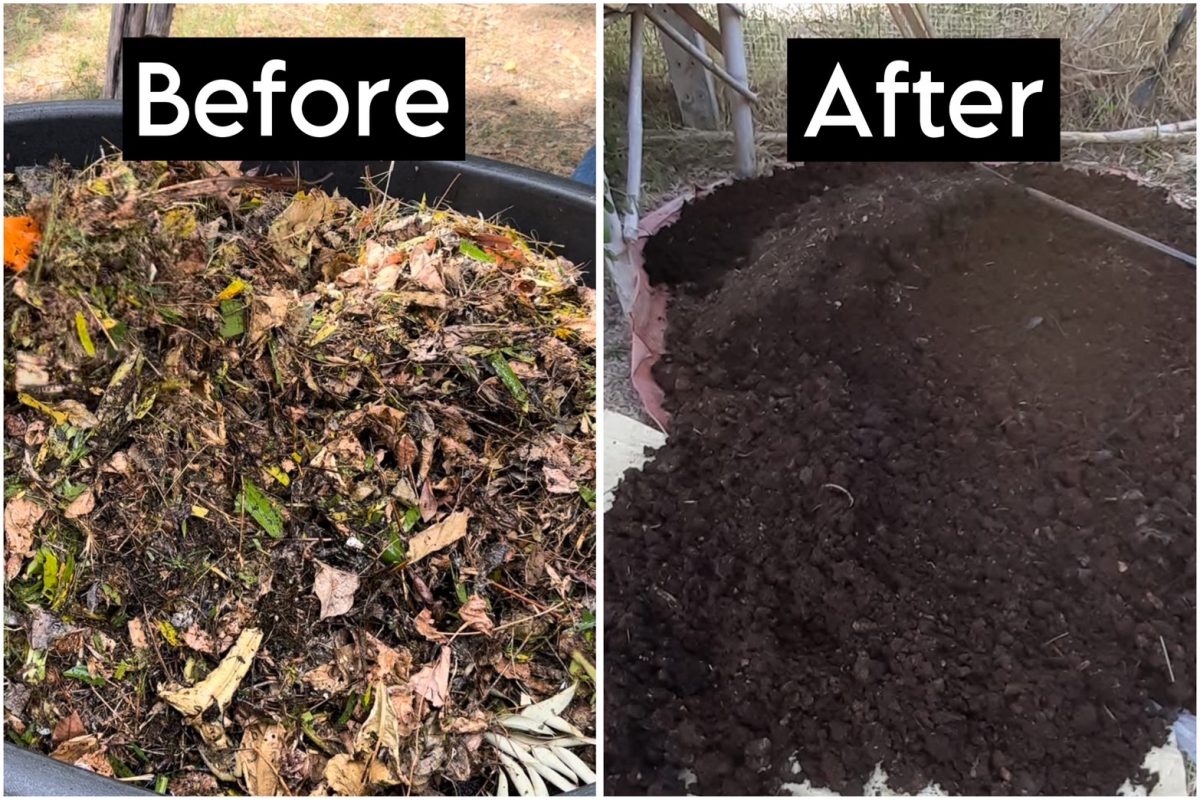
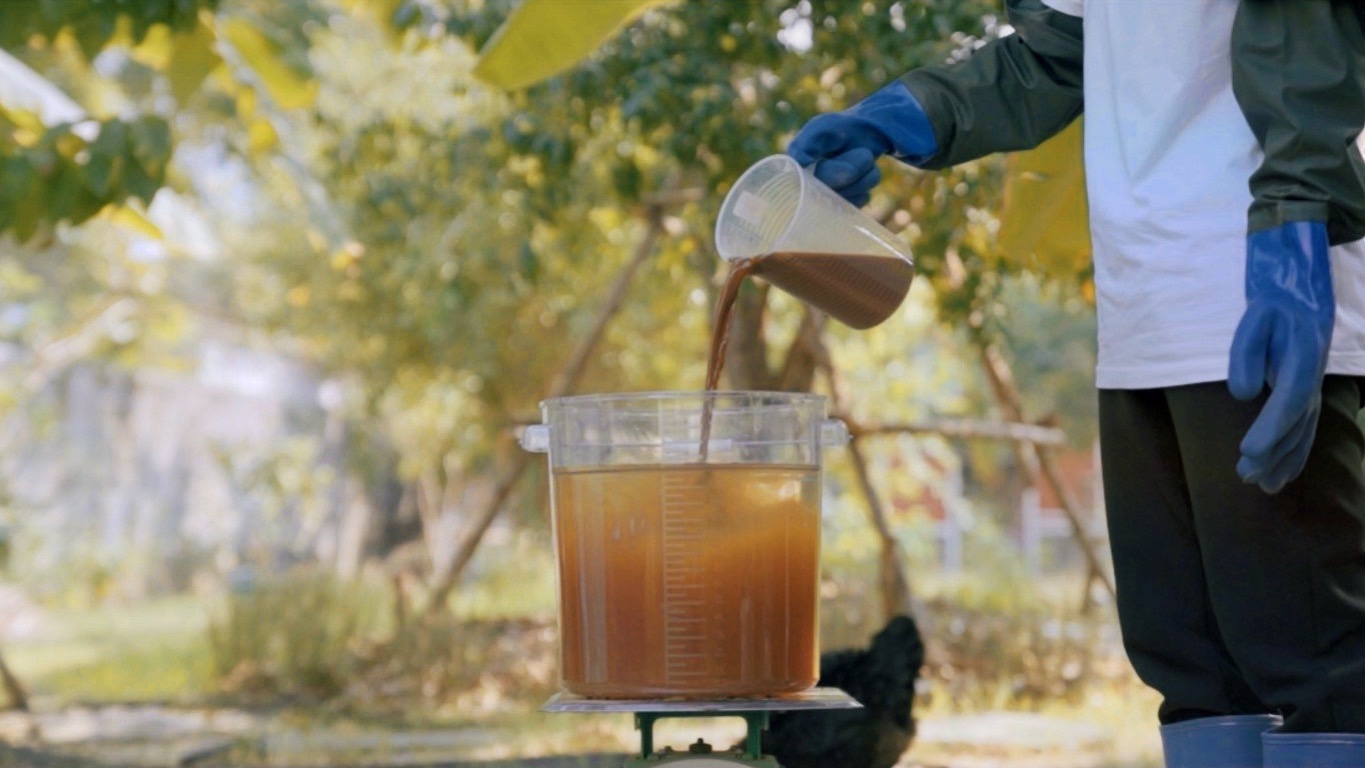
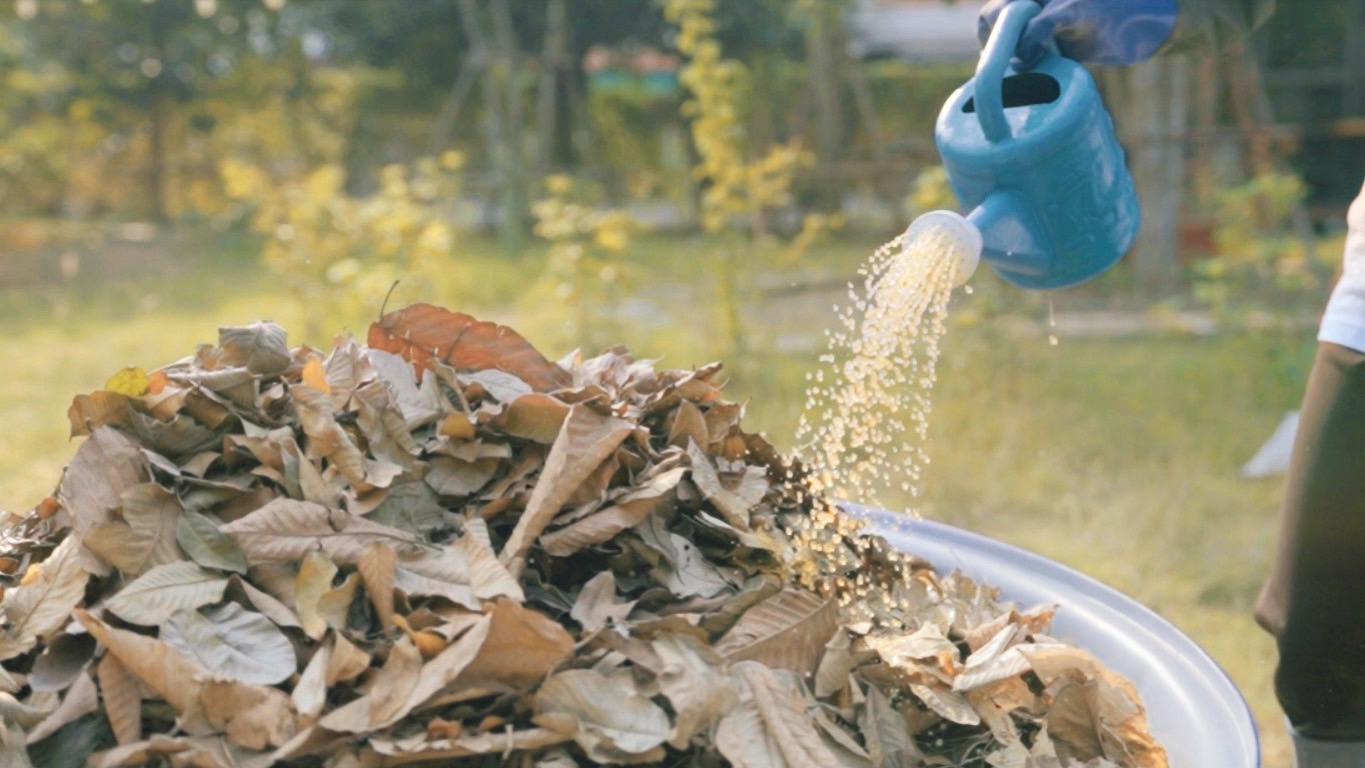
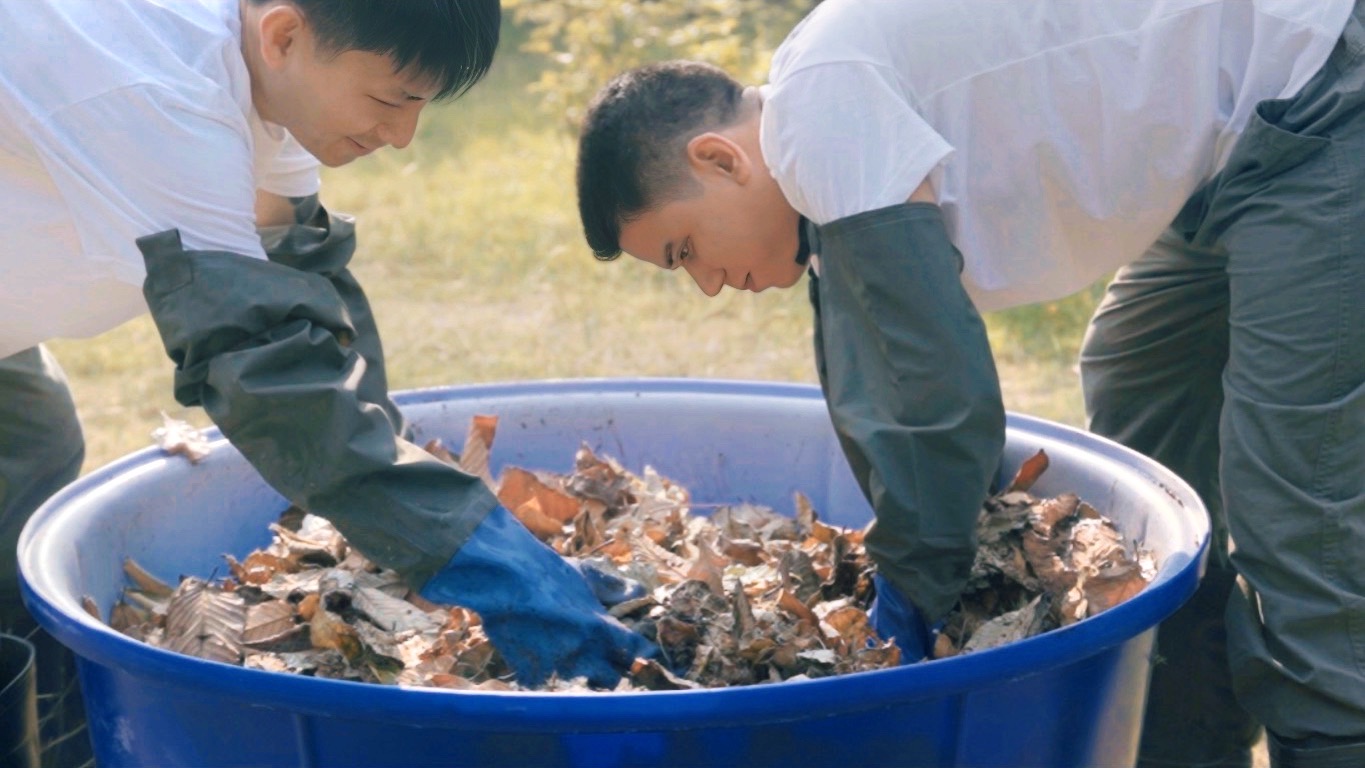
SqueakyGrow Composting Method: Optimized for Coffee Grounds
The SqueakyGrow composting process is designed to maximize the efficiency of composting using coffee grounds as the primary material. With the addition of carefully selected microorganisms, each week targets specific decomposition phases, ensuring high-quality compost in just 4–6 weeks.
Weekly Composting Guidelines
Week 1: Initial Phase (Days 1–7)
- Temperature: 40–50°C
- pH: 5.5–6.0
- Microorganism Used: Lactobacillus spp. (added on Day 1)
Role of Lactobacillus spp.:
- Produces lactic acid to reduce pH, suppressing harmful bacteria that cause foul odors.
- Initiates the breakdown of simple organic materials, such as sugars in banana peels or fruit scraps.
- Creates a favorable environment for other microorganisms by preventing anaerobic conditions.
Key Changes in the Compost:
- Coffee grounds and fresh organic waste begin to soften and decompose.
- The pile heats up quickly, indicating active microbial activity.
- Odors from decomposition are significantly reduced.
Week 2: Thermophilic Phase (Days 8–14)
- Temperature: 50–60°C
- pH: 6.0–7.0
- Microorganism Used: Bacillus subtilis (added on Day 8)
Role of Bacillus subtilis:
- Thrives in high temperatures to break down complex organic compounds, such as cellulose and proteins in dry leaves and coffee grounds.
- Generates heat to sterilize the compost pile, killing pathogens and weed seeds.
- Rapidly reduces the bulk of the compost pile by 20–30%.
Key Changes in the Compost:
- Materials like dry leaves and coffee grounds visibly break down, with the pile volume shrinking significantly.
- The compost develops a fresh, earthy smell, replacing any lingering odors.
- The pile maintains high heat, ensuring efficient decomposition.
Week 3: Mesophilic Phase (Days 15–21)
- Temperature: 40–50°C
- pH: 6.5–7.0
- Microorganism Used: Trichoderma spp. (added on Day 15)
Role of Trichoderma spp.:
- Focuses on breaking down tougher materials, such as lignin and cellulose in dry leaves.
- Suppresses harmful fungi that may form in the compost pile.
- Balances microbial populations to stabilize the compost for the final phase.
Key Changes in the Compost:
- Materials become crumbly and dark in color, resembling finished compost.
- The smell transitions to a rich, earthy aroma.
- The pile volume decreases further, totaling a 30–40% reduction from the initial size.
Weeks 4–6: Stabilization Phase
- Temperature: 30–40°C
- pH: Stable at 6.5–7.0
- Microorganisms: No additional inoculation required.
What Happens During Stabilization:
- Residual organic matter continues to decompose, releasing nutrients slowly.
- Microbial activity stabilizes, ensuring the compost is safe and nutrient-rich.
- The compost achieves its final texture: dark, crumbly, and moist but not wet.
Key Changes in the Compost:
- The pile no longer heats up significantly, indicating completion.
- Finished compost is ready for use in gardening, farming, or urban planting.
Highlights of the SqueakyGrow Composting Process
-
Primary Ingredients:
- Coffee Grounds: Provide nitrogen to accelerate decomposition.
- Fresh Organic Waste: Adds potassium and moisture.
- Dry Leaves: Supply carbon to balance the nitrogen-rich materials.
- Rice Bran: Enhances nutrient content with nitrogen and phosphorus.
-
Microorganism Applications:
- Lactobacillus spp.: Lowers pH and starts decomposition.
- Bacillus subtilis: Works at high temperatures to break down cellulose and sterilize the pile.
- Trichoderma spp.: Stabilizes the compost by breaking down resistant materials and preventing harmful fungi.
-
Results:
- High-quality compost ready within 4–6 weeks.
- Significant waste volume reduction (30–40%).
- Compost rich in organic matter and nutrients, improving soil structure and reducing the need for chemical fertilizers.
By following these weekly guidelines, SqueakyGrow ensures efficient, sustainable composting that transforms coffee waste into a valuable resource for plants and the environment. 🌱
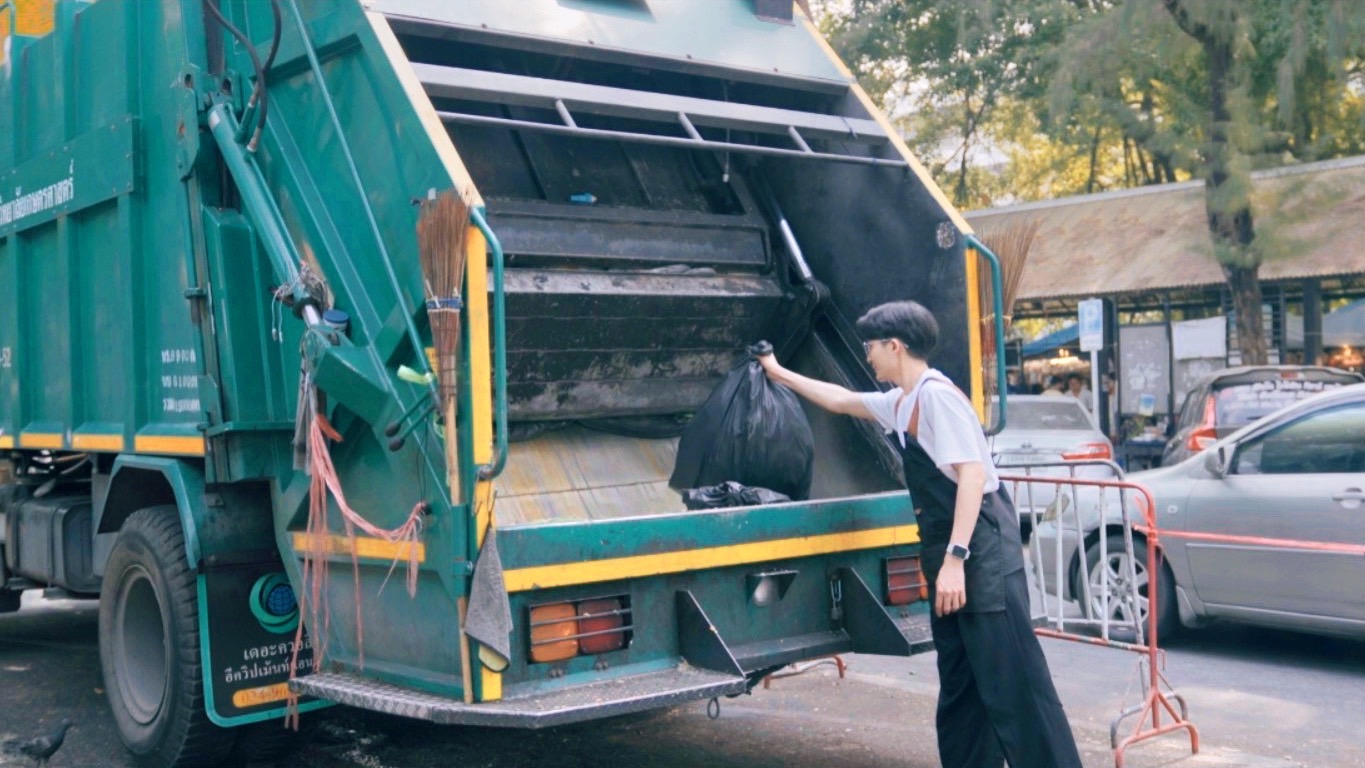
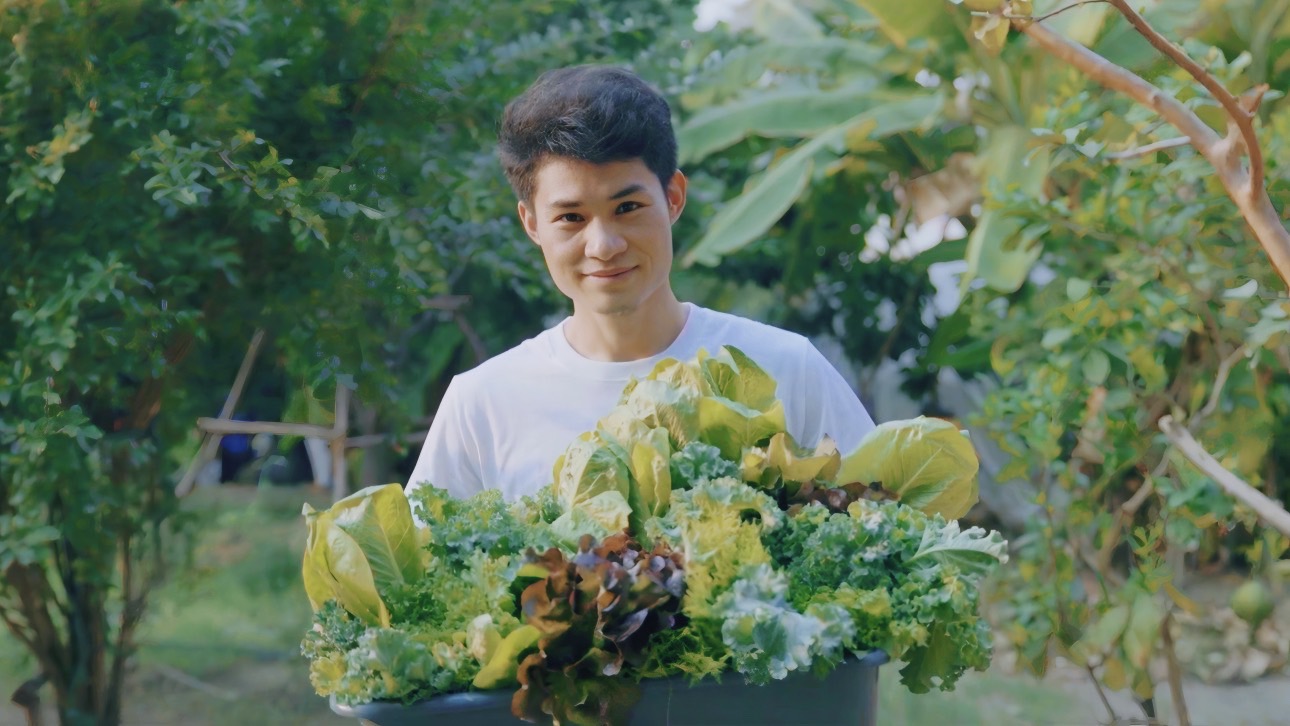
Reducing Coffee Waste & Carbon Footprint
Every cup of coffee leaves behind waste—tons of it. A single café produces approximately 2.4 tons of coffee grounds per year, and globally, coffee waste contributes to millions of tons of organic waste annually. When dumped in landfills, coffee grounds release methane gas (CH₄), a greenhouse gas 25 times more potent than CO₂, accelerating climate change.
By transforming coffee waste into nutrient-rich compost, SqueakyGrow reduces organic waste, prevents methane emissions, and promotes a circular economy. Our composting process not only diverts coffee waste from landfills but also enhances soil health and agricultural productivity.
Supporting Sustainable Agriculture & Communities
✅ Nutritious Soil for Farmers – Our compost is rich in essential nutrients, improving soil fertility while reducing dependency on chemical fertilizers.
✅ Urban Greening Initiatives – We support community gardens and urban farms by supplying them with sustainable compost.
✅ Economic Value Creation – Instead of treating coffee waste as trash, we turn it into a valuable resource, helping coffee shops, farmers, and local communities.
Fostering Awareness & Environmental Education
At SqueakyGrow, we believe in the power of knowledge-sharing. Through educational workshops and community engagement, we empower individuals and businesses to adopt sustainable waste management practices.
✅ Engaging Cafés & Businesses – Partnering with coffee shops to implement zero-waste solutions.
✅ Educating Future Generations – Providing training sessions on composting, sustainability, and climate impact.
✅ Promoting a Global Movement – Encouraging businesses worldwide to rethink their waste and contribute to environmental solutions.
A Future Without Waste Starts Today
SqueakyGrow is more than just composting—it’s a commitment to a sustainable future. By closing the loop on coffee waste, we can reduce carbon emissions, enrich soil health, and build a world where waste is seen as a resource, not a burden.
🌍 Join us in making every cup of coffee part of the solution, not the problem.

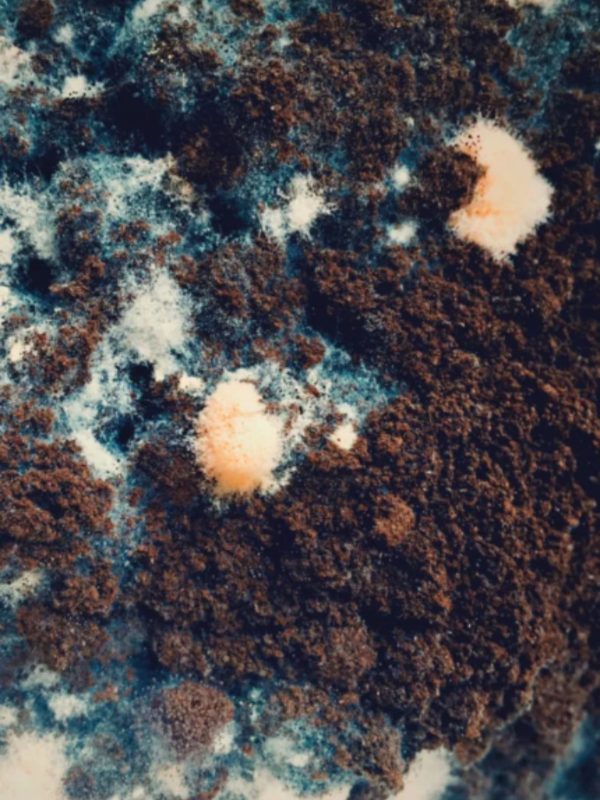
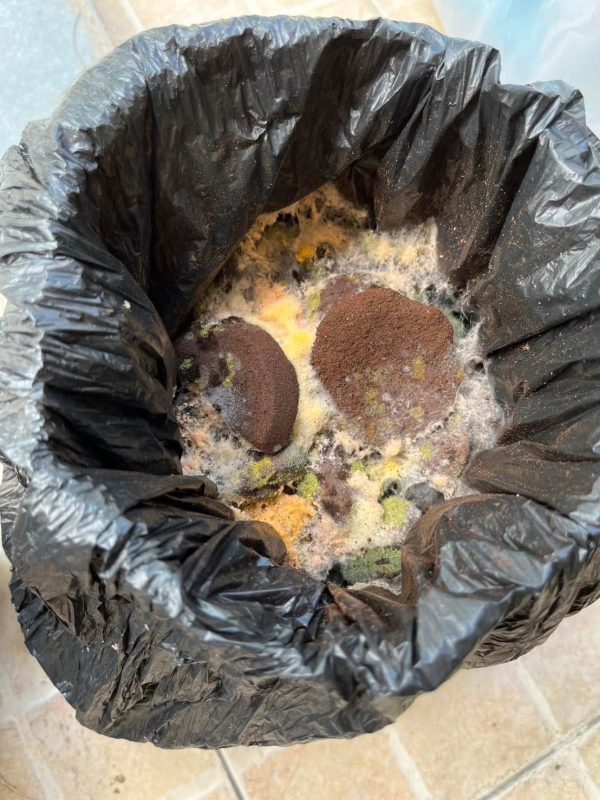
The Impact of Coffee Ground Landfilling: Mold, Toxins, and Environmental Threats
When coffee grounds are disposed of in landfills without proper management, they cause severe environmental and health issues, especially through mold growth and decomposition-related pollution.
1. Mold Growth and Toxins from Coffee Grounds
☕ Coffee grounds are highly moist and nutrient-rich, making them a perfect breeding ground for harmful molds, such as:
✅ Aspergillus spp. – Produces aflatoxins, which are carcinogenic.
✅ Penicillium spp. – Releases toxins that can cause allergic reactions, respiratory inflammation, and skin problems.
✅ Fusarium spp. – Harms plants and animals, potentially affecting the digestive system.
2. Health Risks to Humans and Animals
☠️ When mold spores become airborne, they can enter the respiratory system, leading to:
❌ Respiratory diseases such as asthma, allergies, and aspergillosis (lung infection caused by mold exposure).
❌ Eye and skin irritation.
❌ Toxin poisoning if contaminated food is ingested.
3. Greenhouse Gas Emissions from Coffee Grounds in Landfills
☠️ Coffee grounds in landfills undergo anaerobic decomposition (breakdown without oxygen), releasing methane (CH₄), a greenhouse gas 25 times more potent than carbon dioxide (CO₂) in trapping heat.
📌 Methane emissions from landfilled coffee grounds:
• 1 ton of coffee grounds produces ~50 kg of methane.
• If 100,000 coffee shops landfill their coffee grounds annually, they release:
50 kg × 730,000 tons = 36,500,000 kg (36,500 tons) of methane per year.
• This is equivalent to 912,500 tons of CO₂ emissions or the annual emissions of 200,000 cars.
4. Soil and Water Contamination
♻️ As coffee grounds decompose, they release leachate (contaminated liquid), which:
❌ Pollutes groundwater, leading to serious environmental risks.
❌ Harms soil organisms and plant growth.
❌ Alters soil pH levels, degrading soil quality over time.
5. Increased Pest and Public Health Issues
🐛 Decomposing coffee grounds attract pests and disease carriers:
✅ They provide breeding grounds for flies, rodents, and agricultural pests.
✅ This contributes to the spread of bacteria and pathogens in the environment.
🔄 The SqueakyGrow Solution: Composting Instead of Landfilling
🌱 SqueakyGrow uses aerobic composting (oxygen-based decomposition) to eliminate mold risks and reduce greenhouse gas emissions.
✅ Microbial inoculants such as Lactobacillus spp., Bacillus subtilis, and Trichoderma spp. ensure rapid and safe decomposition.
✅ Eliminates mold and toxins from coffee waste.
✅ Reduces methane emissions by 100%.
✅ Enriches soil instead of degrading it.
📌 Conclusion: Landfilled Coffee Grounds = Environmental and Health Disaster
❌ Breeding ground for harmful molds and toxins.
❌ Massive methane emissions contributing to climate change.
❌ Soil and water contamination through toxic leachate.
❌ Pest infestations and public health risks.
✅ SqueakyGrow transforms coffee waste into organic compost, cutting waste, reducing emissions, and fostering a sustainable circular economy.
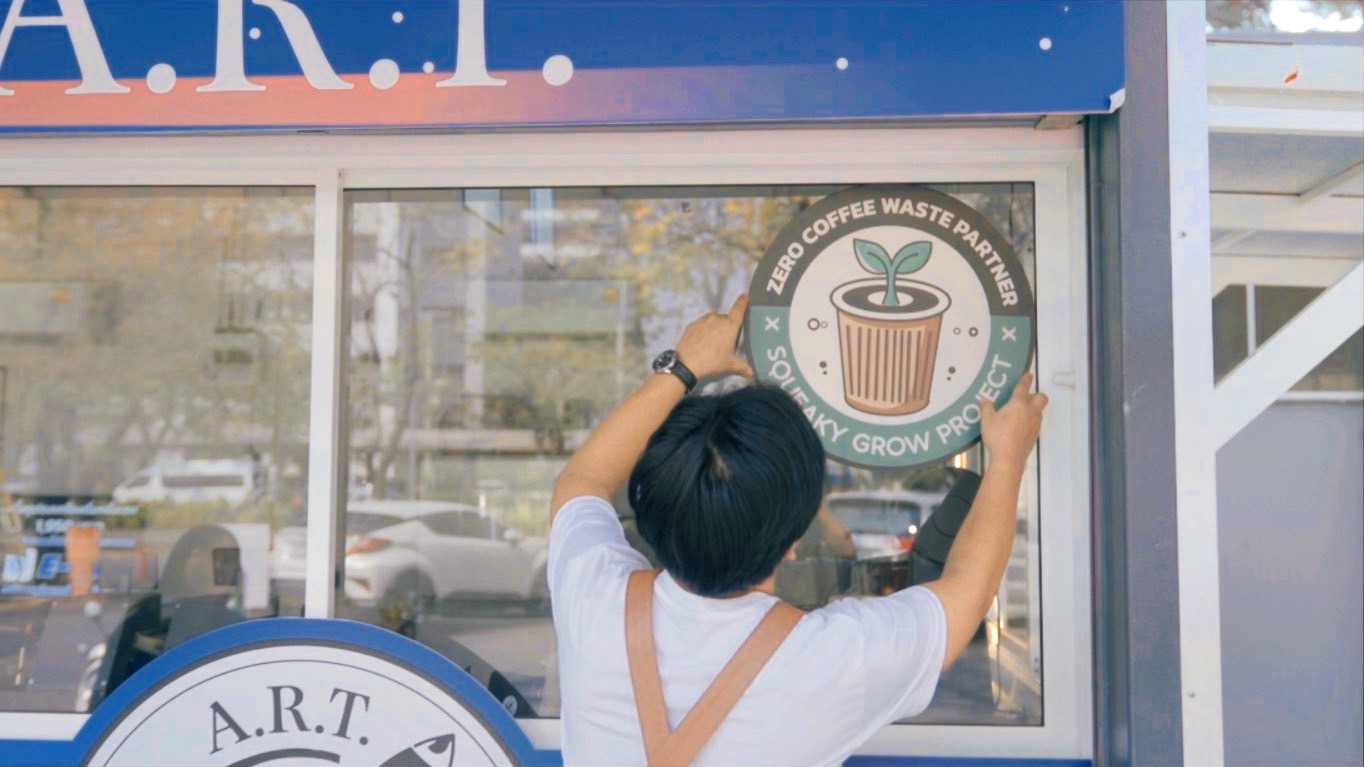

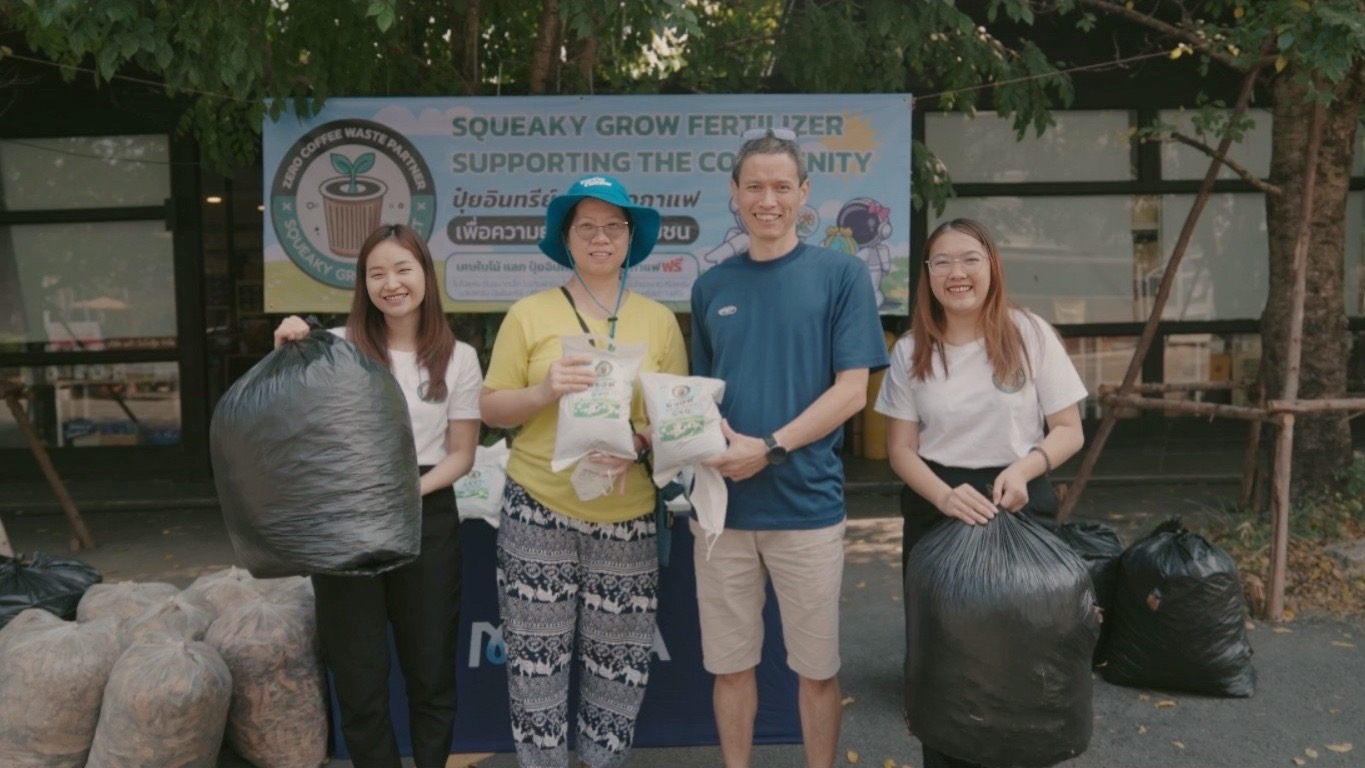
Be a Part of the Change 🌍♻️
At SqueakyGrow, we believe small actions can lead to big impacts. By transforming coffee waste into compost, we’re helping to reduce landfill waste, cut greenhouse gas emissions, and promote a circular economy. But we can’t do it alone—we need you to be part of this movement!
Ways You Can Get Involved
✅ Coffee Shops & Businesses
- Partner with us to sustainably repurpose your coffee waste.
✅ Farmers & Urban Gardeners
- Enrich your soil naturally with our nutrient-rich compost.
✅ Individuals & Communities
- Learn, compost, and raise awareness about sustainable waste management.
Why Join SqueakyGrow?
🌱 Make a tangible impact on waste reduction and climate change.
🌱 Help create a zero-waste coffee culture.
🌱 Support local farmers and eco-friendly agriculture.
🌱 Promote environmental awareness in your community.
Get Recognized for Sustainability
Coffee shops that join our Zero-Waste Coffee Initiative will receive a “Zero Waste Partner” sticker to proudly display their commitment to sustainability.
☕ Every coffee shop, every individual, every action counts. Let’s build a future where coffee waste becomes a valuable resource, not a burden.
Join the Movement Today!
Start composting and help turn coffee waste into a solution for a greener, cleaner world. 🌱 Together, we can make a difference!
SqueakyGrow
“Turning Coffee Waste into a Greener Future”
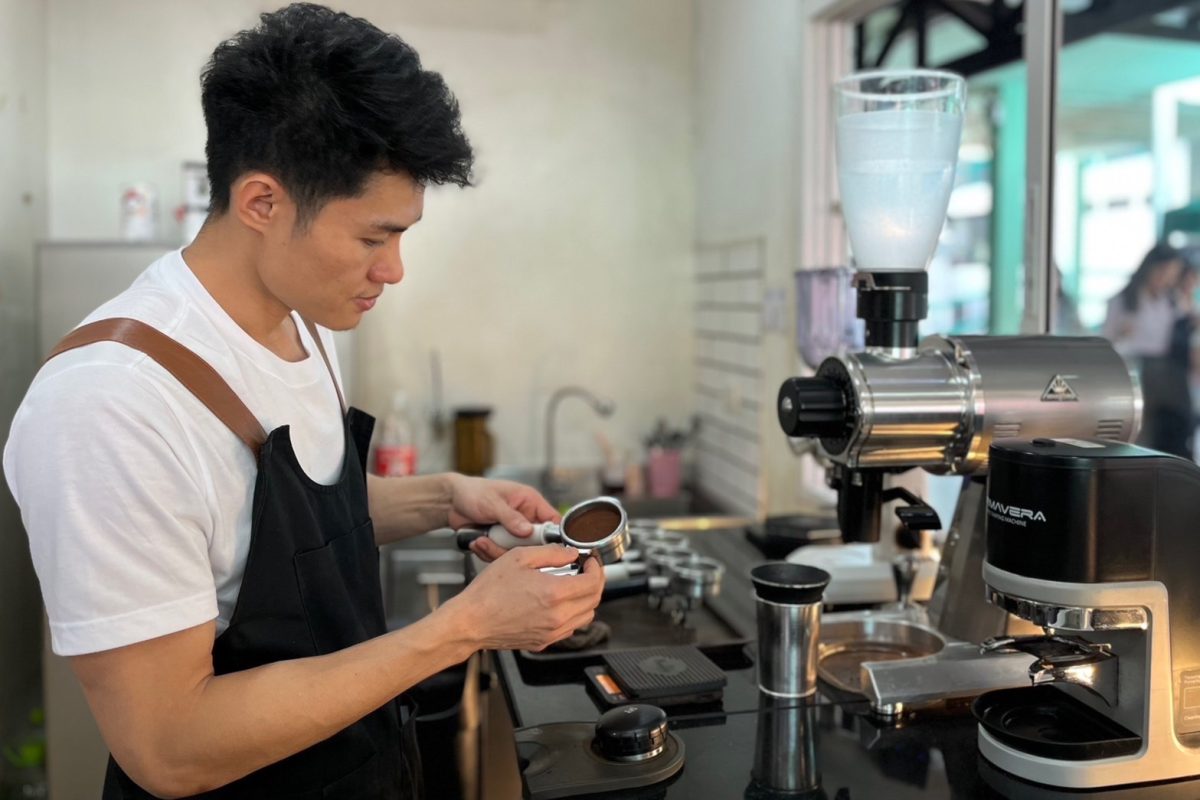
From Coffee Grounds to Fertilizer
Every cup of coffee waste starts a new journey towards a sustainable future, reducing landfill waste and enriching the soil.
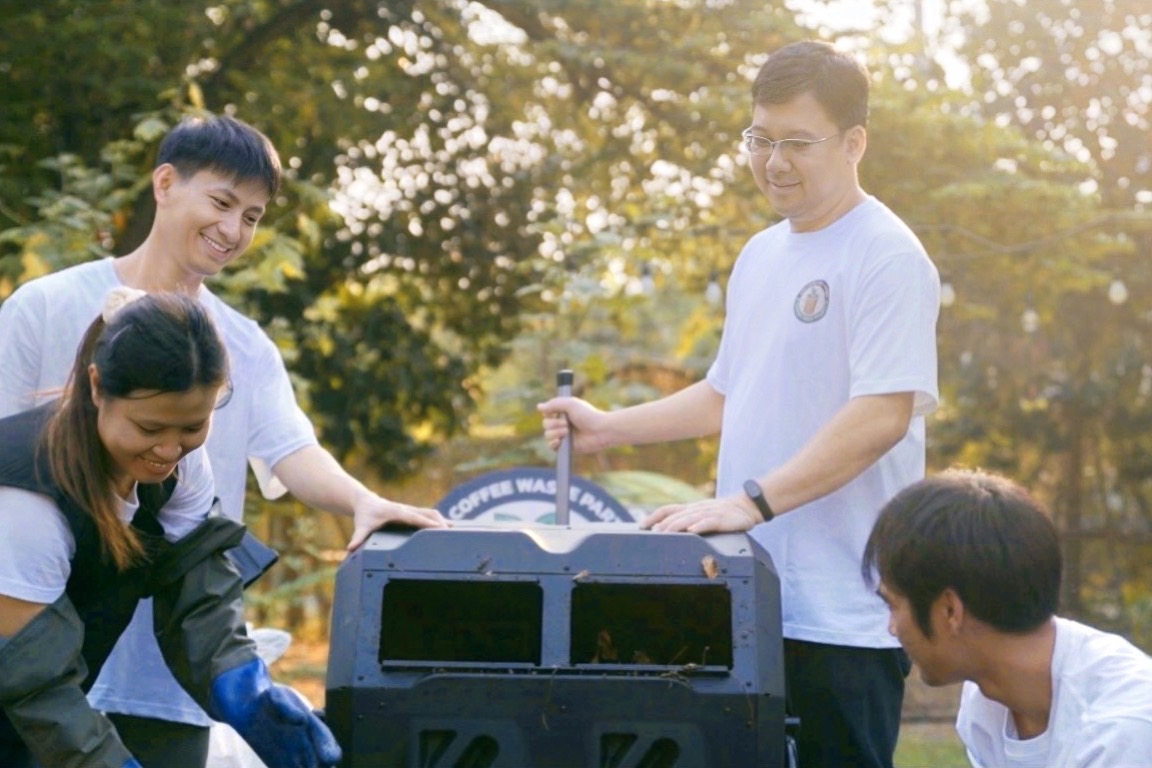
Composting Waste into Resources
With natural microorganisms, organic waste transforms into valuable compost, turning everyday waste into an asset for agriculture.
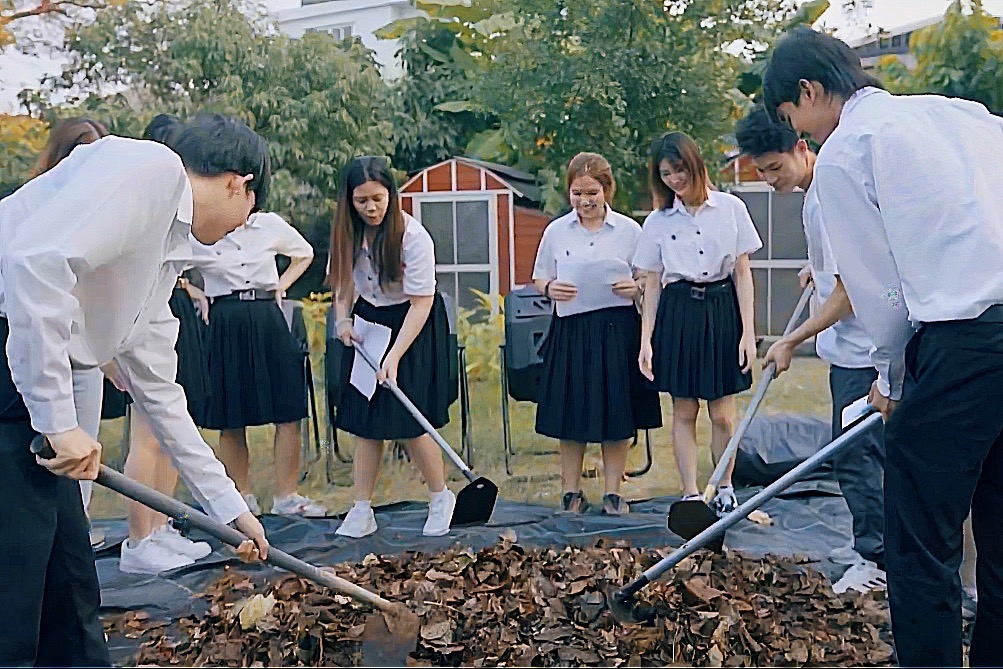
Growing & Empowering
The compost supports farmers while sharing sustainable waste management practices with everyone.
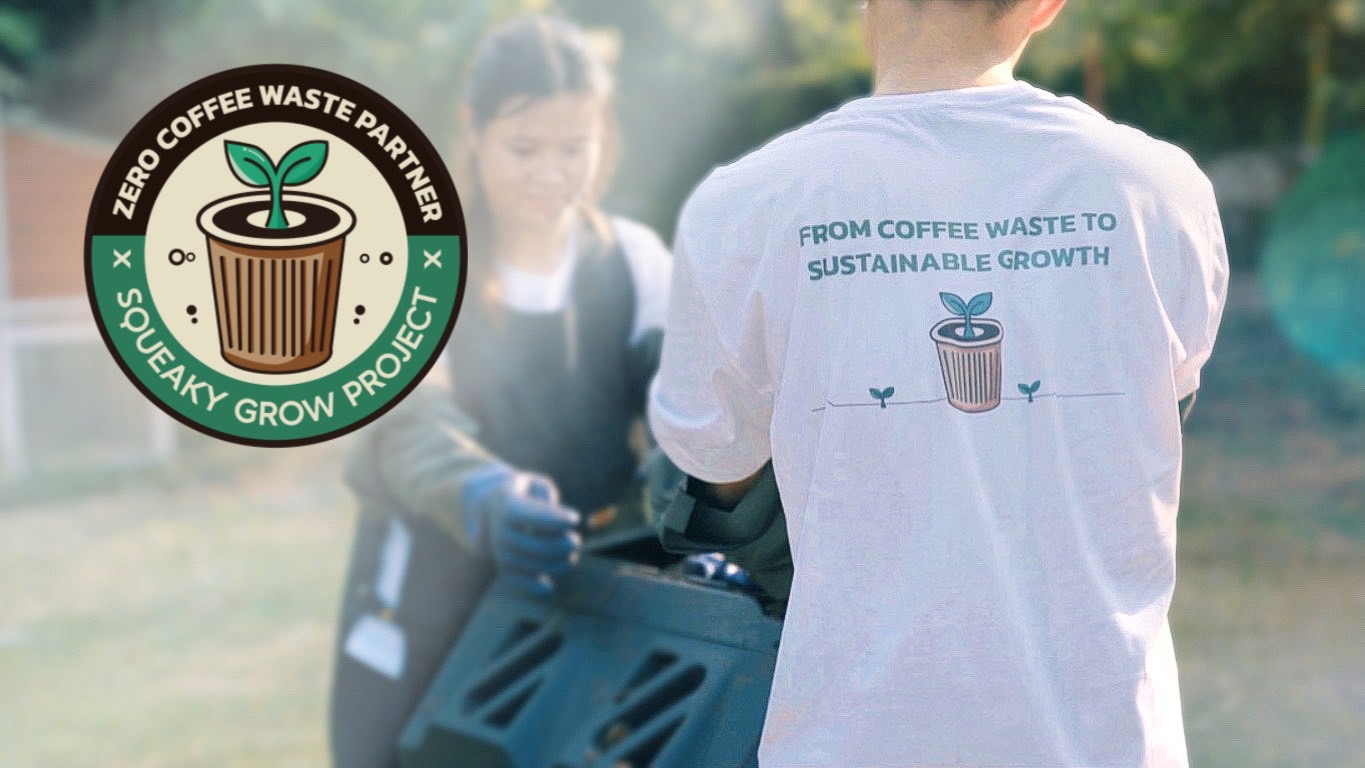
SqueakyGrow is not just an ordinary environmental project; it is a tangible transformation:
✅ Reduces global coffee waste and transforms it into a valuable resource
✅ Lowers the carbon footprint of the coffee industry by reducing greenhouse gas emissions
✅ Builds a collaborative network between coffee shops, communities, and farmers to promote a circular economy
✅ Can be implemented globally in coffee shops of all sizes


Cafe : A.R.T.
Bangkok, Thailand
A.R.T. Participation in the Project (2020–Present)
-
Daily coffee grounds production:
6.6 kilograms per day -
Annual coffee grounds production:
~2,409 kilograms (2.41 tons) -
Total coffee grounds produced since 2020:
~12,045 kilograms (12.05 tons) (over 5 years) -
Estimated organic compost production (5 years):
~8.43 tons -
Reduction in methane emissions (CH₄):
603 kilograms of CH₄ reduced over 5 years, equivalent to 15.08 tons CO₂-e of greenhouse gas reduction.

Cafe : Meka.Coffee
Nontaburi, Thailand
Meka.Coffee’s Participation in the Project (2023–Present)
-
Daily coffee grounds production:
3 kilograms per day -
Annual coffee grounds production:
~1,095 kilograms (1.1 tons) -
Estimated organic compost production per year:
~730 kilograms -
Reduction in methane emissions (CH₄):
54.75 kilograms of CH₄ per year, equivalent to 1.37 tons CO₂-e of greenhouse gas reduction.
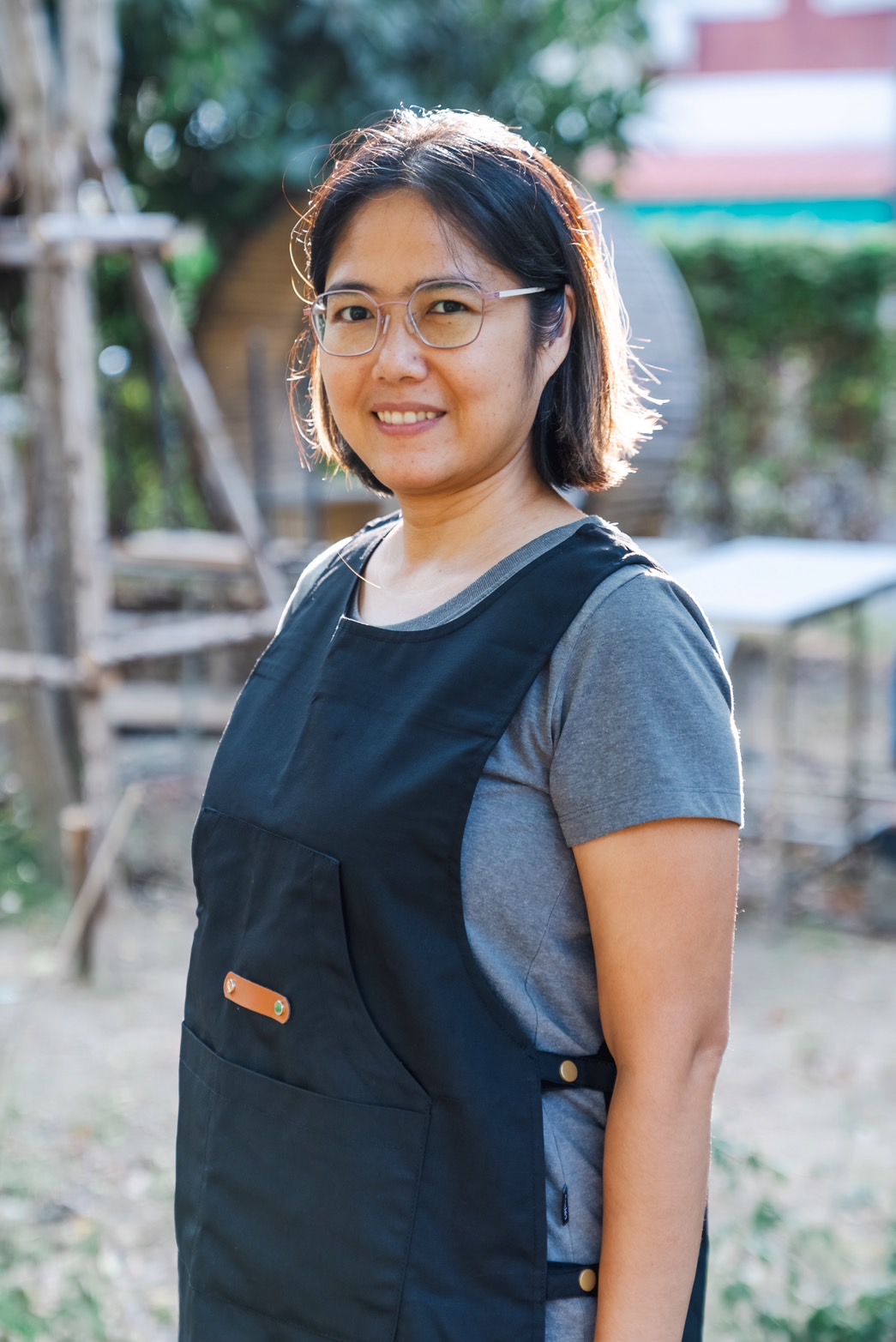
Cafe : Squeaky
Bangkok, Thailand
Squeaky’s Participation in the Project (2022–Present)
-
Daily coffee grounds production:
10 kilograms per day -
Annual coffee grounds production:
~3,650 kilograms (3.65 tons) -
Estimated organic compost production per year:
~2.43 tons -
Reduction in methane emissions (CH₄):
182.5 kilograms of CH₄ per year, equivalent to 4.56 tons CO₂-e of greenhouse gas reduction.

Cafe : Tonmai Koff
Bangkok, Thailand
Tonmai Koff Participation in the Project (2023–Present)
-
Daily coffee grounds production:
7 kilograms per day -
Annual coffee grounds production:
~2,555 kilograms (2.56 tons) -
Estimated organic compost production per year:
~1.79 tons -
Reduction in methane emissions (CH₄):
127.75 kilograms of CH₄ per year, equivalent to 3.19 tons CO₂-e of greenhouse gas reduction.

Cafe : Airr Roastery
Nontaburi, Thailand
Airr Roastery Participation in the Project (Late 2021–Present)
-
Daily coffee grounds production:
8.5 kilograms per day -
Annual coffee grounds production:
~3,102 kilograms (3.10 tons) -
Total coffee grounds produced since late 2021 (2 years):
~6,204 kilograms (6.20 tons) -
Estimated organic compost production over 2 years:
~4.34 tons -
Reduction in methane emissions (CH₄):
310.2 kilograms of CH₄ over 2 years, equivalent to 7.76 tons CO₂-e of greenhouse gas reduction.

Cafe : Handbrew Slowbar
Nontaburi, Thailand
Handbrew Participation in the Project (2023–Present)
-
Daily coffee grounds production:
11 kilograms per day -
Annual coffee grounds production:
~4,015 kilograms (4.02 tons) -
Estimated organic compost production per year:
~2.81 tons -
Reduction in methane emissions (CH₄):
200.75 kilograms of CH₄ per year, equivalent to 5.02 tons CO₂-e of greenhouse gas reduction.

Cafe : 2Espresso
Patumthani, Thailand
Cafe: 2Espresso Participation in the Project (2024–Present)
-
Daily coffee grounds production:
6.5 kilograms per day -
Annual coffee grounds production:
~2,373 kilograms (2.37 tons) -
Estimated organic compost production per year:
~1.66 tons -
Reduction in methane emissions (CH₄):
118.65 kilograms of CH₄ per year, equivalent to 2.97 tons CO₂-e of greenhouse gas reduction.
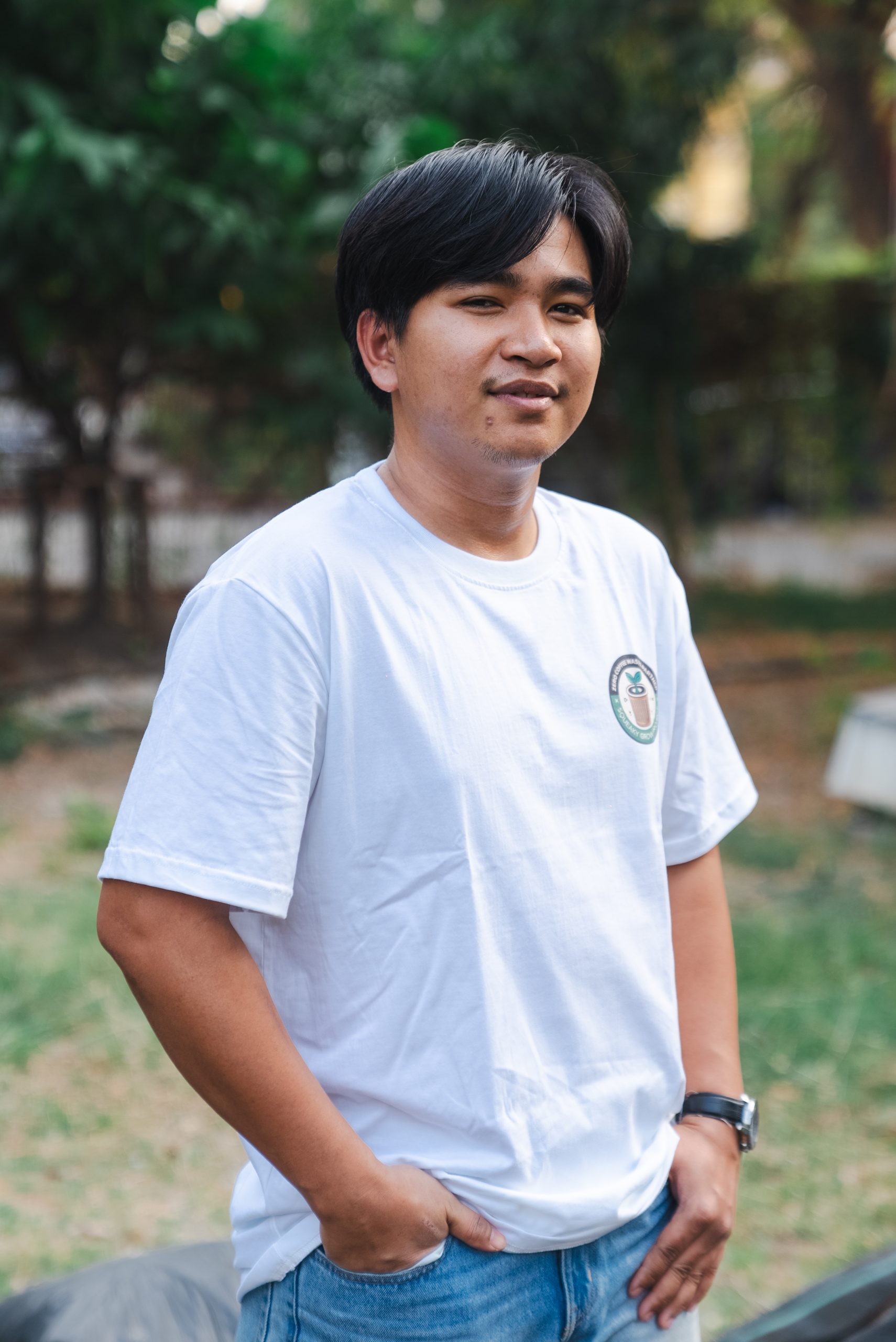
Cafe : MIX Coffee
Bangkok, Thailand
MIX Coffee Participation in the Project (Late 2022–Present)
-
Daily coffee grounds production:
9 kilograms per day -
Annual coffee grounds production:
~3,285 kilograms (3.29 tons) -
Estimated organic compost production per year:
~2.30 tons -
Reduction in methane emissions (CH₄):
164.25 kilograms of CH₄ per year, equivalent to 4.11 tons CO₂-e of greenhouse gas reduction.

Cafe : Yoong Cafe
Bangkok, Thailand
Yoong Cafe’s Participation in the Project (2021–2024)
-
Daily coffee grounds production:
8 kilograms per day -
Total coffee grounds produced in 3 years:
8,760 kilograms (8.76 tons) -
Total organic compost produced:
6.13 tons (averaging 2 tons per year) -
Reduction in methane emissions (CH₄):
Reduced 438 kilograms of CH₄, equivalent to a 10.95-ton CO₂-e reduction in greenhouse gases.
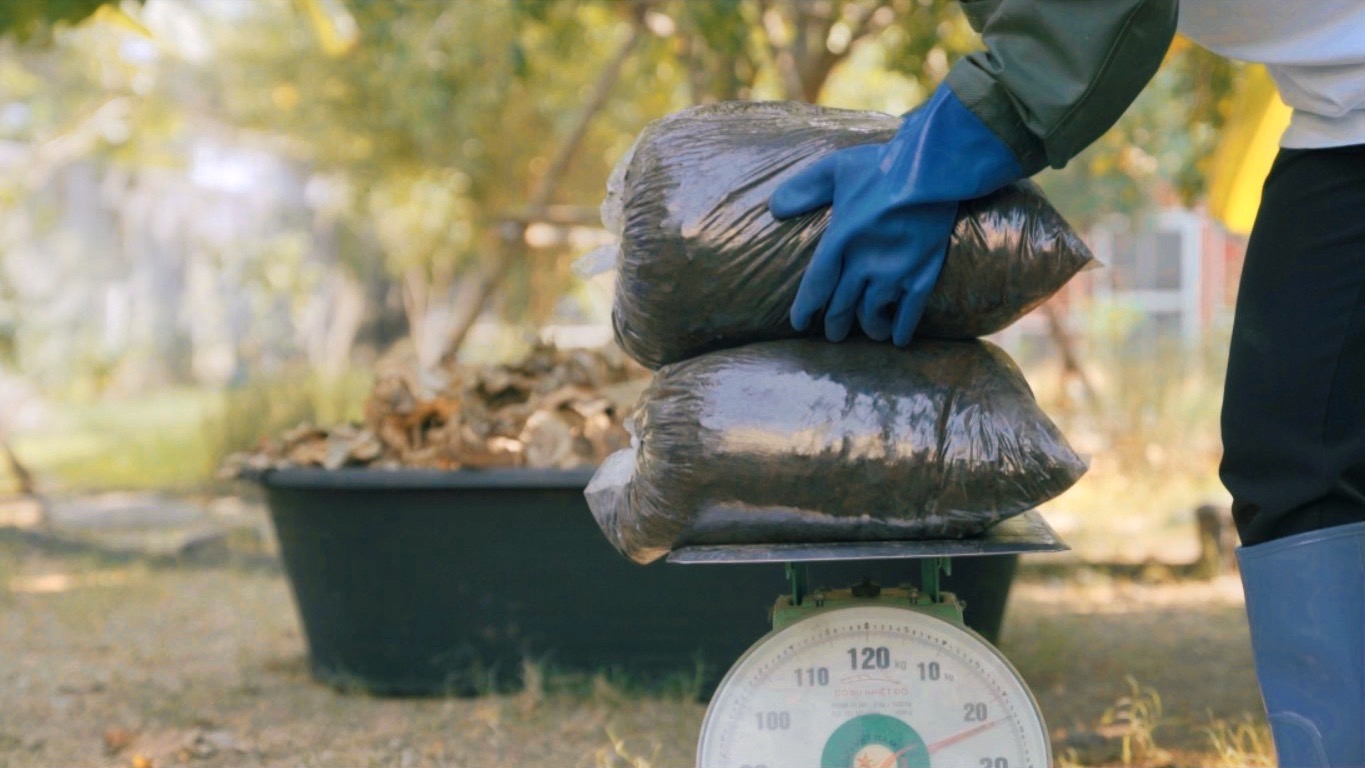
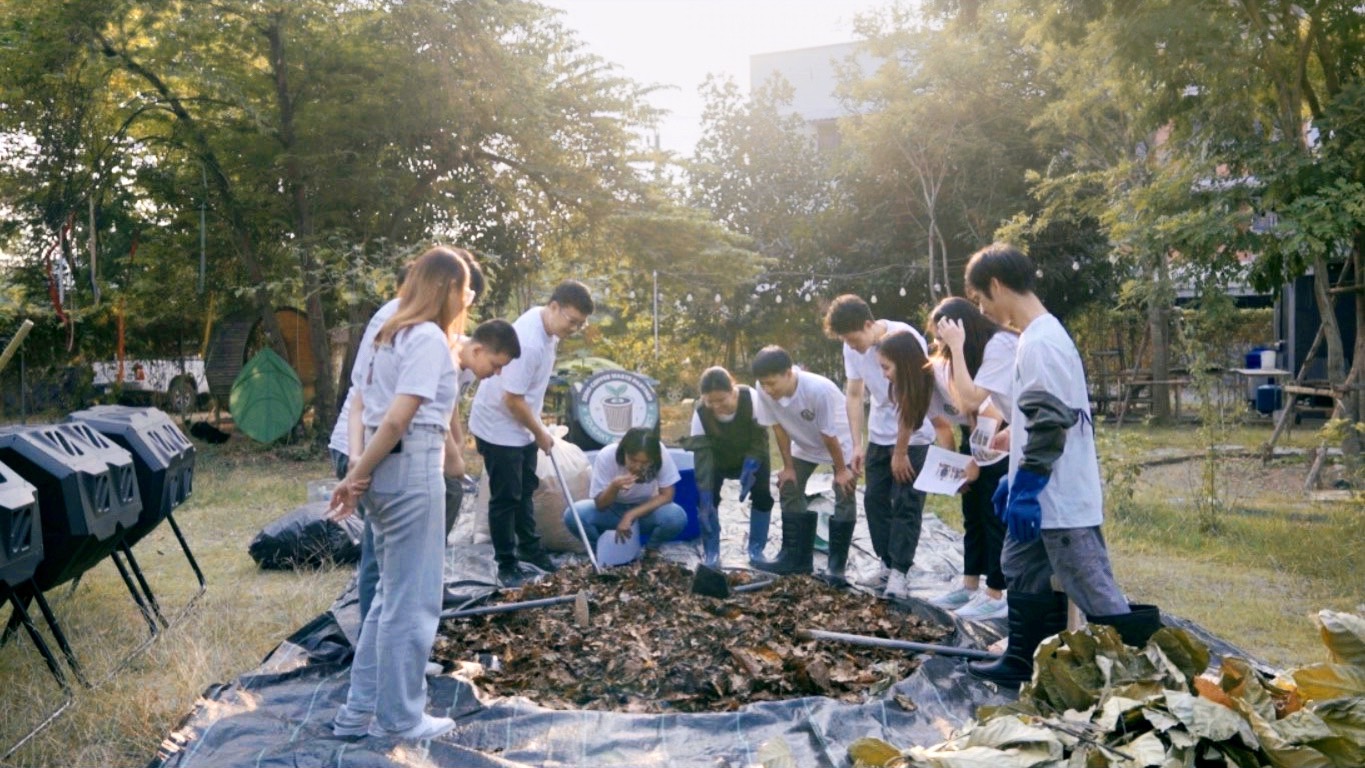

Summary of Total Contributions from Participating Cafes (to end of 2024)
- Total coffee grounds produced: 43.98 tons
- Total organic compost produced: 39 tons
- Total methane emissions reduced: 2.2 tons CH₄
- Equivalent CO₂-e reduction: 55.02 tons CO₂-e
